Winter in the Greenhouse
By Olivia Steinmetz | February 2, 2022
As the days get shorter and winter sets in, our research focus turns from field work to the greenhouse and laboratory here at the Research and Learning Center in Waupaca, Wisconsin. For the past few months Travis and I have been busy killing alfalfa plants. Turns out, this is an important step in developing new, excellent alfalfa varieties!
 When you purchase an alfalfa variety, you probably take notice of its disease resistance score. But where does that rating come from? That resistance score is the result of years of work in the greenhouse and field. As we develop new alfalfa varieties, we continually integrate disease resistance into its gene pool. Disease resistance is the visible phenotype for having the resistance gene(s) in the alfalfa’s genotype. Since all our alfalfa is bred conventionally (not with genetic engineering), we must find those resistant genes the old-fashioned way. To put it bluntly, this means putting our alfalfa through a controlled disease inoculation where plants without the resistance genes we’re looking for die, and the plants that have the resistance genes we want survive that inoculation. We keep the survivors in the greenhouse for a few months, and eventually transplant them into our field nurseries where they will be further analyzed.
When you purchase an alfalfa variety, you probably take notice of its disease resistance score. But where does that rating come from? That resistance score is the result of years of work in the greenhouse and field. As we develop new alfalfa varieties, we continually integrate disease resistance into its gene pool. Disease resistance is the visible phenotype for having the resistance gene(s) in the alfalfa’s genotype. Since all our alfalfa is bred conventionally (not with genetic engineering), we must find those resistant genes the old-fashioned way. To put it bluntly, this means putting our alfalfa through a controlled disease inoculation where plants without the resistance genes we’re looking for die, and the plants that have the resistance genes we want survive that inoculation. We keep the survivors in the greenhouse for a few months, and eventually transplant them into our field nurseries where they will be further analyzed.
We do this process for every disease, and for every potential variety! Some of the major diseases are Aphanomyces Root Rot, Fusarium Wilt, Anthracnose, and Phytophthora Root Rot. Every disease that we work with has its own standard protocol that we follow, so we know the results are valid.
Those hardy plants that survive the disease inoculations and spend a few years outside in the nursery are later used as “parents” for a future variety. Along with testing the yield, quality, and persistence of the new variety, we screen it against all those diseases again to get its final score. For example, L-451APH2+ has a score of 35/35 which means it is highly resistant to the top 7 diseases (HR score of 5 x the 7 diseases = 35) thanks to the disease resistance genes that its parents had.
Check out our commercial Alfalfa performance.

